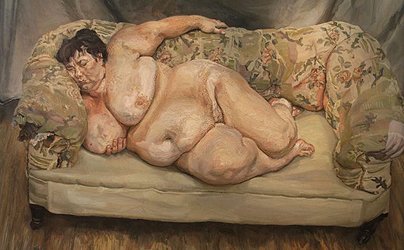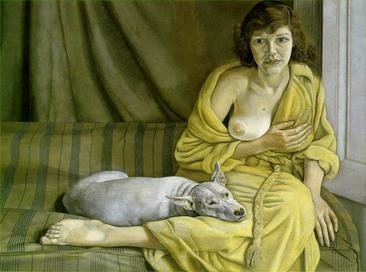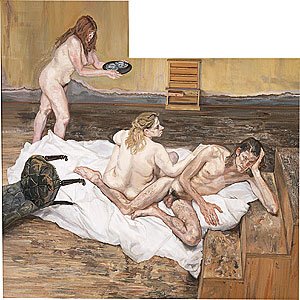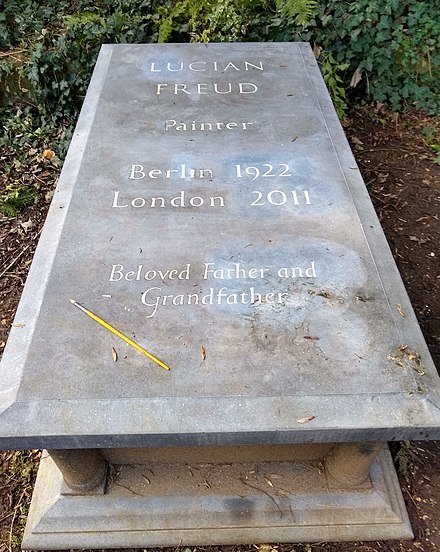British Heritage
Remember, Cherish, Learn.
beta
Lucian Freud
A Legacy of British Heritage.
Lucian Michael Freud, a prominent British painter and draughtsman, left an indelible mark on British heritage through his masterful contributions to figurative art. Born on December 8, 1922, in Berlin, Freud's artistic journey was deeply intertwined with his personal history, marked by his Jewish heritage and a family that sought refuge in England to escape the threat of Nazism. The grandson of the renowned psychoanalyst Sigmund Freud, Lucian Freud's creative talents would eventually elevate him to become one of the foremost English portraitists of the 20th century.
Lucian Freud's life began in the vibrant city of Berlin, where he was born to a German Jewish mother, Lucie, and an Austrian Jewish father, Ernst L. Freud, who was the son of Sigmund Freud. In 1933, the family decided to emigrate to St John's Wood, London, to evade the rising threat of Nazism in Germany. This move marked the beginning of Freud's association with Britain, which would become a significant part of his identity.
Freud's early artistic endeavors were influenced by surrealism, but as the 1950s approached, his style evolved towards a more realistic portrayal of subjects. His paintings, often somber and thickly impastoed, were primarily centered around friends and family. Portraits became his primary focus, showcasing his extraordinary talent in capturing the psychological depth of his subjects. He was known for demanding long and rigorous sittings from his models to achieve a profound understanding of their personalities.
During the early years of his career, Freud associated with a group of figurative artists known as the "School of London." This loosely connected group included prominent artists like Francis Bacon and Frank Auerbach, who worked in contrast to the prevalent abstract expressionism of the time. Freud's distinctive style involved using large hog's-hair brushes and thick paint, which he applied meticulously to create textured and vibrant depictions of flesh.
Freud's work holds immense significance for British heritage due to its autobiographical nature and its portrayal of the people in his life. Through his paintings, he captured the essence of British society, providing a visual representation of the people and places that shaped the nation's cultural fabric. His portraits of notable figures, including fellow artists and public figures, offered a glimpse into the artistic and social milieu of the era.
Freud's intimate and candid representations of his subjects, whether family members, friends, or lovers, serve as valuable historical documents that offer insights into the psyche of the individuals and the societal dynamics of the time. His use of animals, horses in particular, and detailed views of London roofscapes further contributed to the cultural landscape of the nation through his unique artistic lens.
Throughout his career, Lucian Freud gained recognition for his extraordinary talent and unique approach to portraiture. His paintings were not only celebrated within the art world but also attained remarkable commercial success, breaking auction records for living artists. One of his most famous works, "Benefits Supervisor Sleeping" (1995), sold for an astounding $33.6 million, setting a record at that time.
Freud's impact extended beyond the art world; he also became known for his personal life, which involved relationships with various partners and numerous children. His legacy as an artist and the rich tapestry of his life have continued to intrigue and inspire generations of artists and art enthusiasts, leaving an enduring imprint on British heritage.
Lucian Freud's artistic journey from Berlin to Britain and his exceptional contributions to figurative art have solidified his place in British heritage. As one of the foremost English portraitists of the 20th century, Freud's intimate and psychologically penetrating paintings have left an indelible mark on the art world and provided a profound visual narrative of the people, places, and relationships that shaped British society. His legacy as a painter and draughtsman will continue to resonate, serving as a timeless testament to the power of art in reflecting and preserving cultural heritage.
Early Life and Family
Lucian Freud's life began in the vibrant city of Berlin, where he was born to a German Jewish mother, Lucie, and an Austrian Jewish father, Ernst L. Freud, who was the son of Sigmund Freud. In 1933, the family decided to emigrate to St John's Wood, London, to evade the rising threat of Nazism in Germany. This move marked the beginning of Freud's association with Britain, which would become a significant part of his identity.
Early Career and Artistic Development
Freud's early artistic endeavors were influenced by surrealism, but as the 1950s approached, his style evolved towards a more realistic portrayal of subjects. His paintings, often somber and thickly impastoed, were primarily centered around friends and family. Portraits became his primary focus, showcasing his extraordinary talent in capturing the psychological depth of his subjects. He was known for demanding long and rigorous sittings from his models to achieve a profound understanding of their personalities.
During the early years of his career, Freud associated with a group of figurative artists known as the "School of London." This loosely connected group included prominent artists like Francis Bacon and Frank Auerbach, who worked in contrast to the prevalent abstract expressionism of the time. Freud's distinctive style involved using large hog's-hair brushes and thick paint, which he applied meticulously to create textured and vibrant depictions of flesh.
Contributions to British Heritage
Freud's work holds immense significance for British heritage due to its autobiographical nature and its portrayal of the people in his life. Through his paintings, he captured the essence of British society, providing a visual representation of the people and places that shaped the nation's cultural fabric. His portraits of notable figures, including fellow artists and public figures, offered a glimpse into the artistic and social milieu of the era.
Freud's intimate and candid representations of his subjects, whether family members, friends, or lovers, serve as valuable historical documents that offer insights into the psyche of the individuals and the societal dynamics of the time. His use of animals, horses in particular, and detailed views of London roofscapes further contributed to the cultural landscape of the nation through his unique artistic lens.
Success and Influence
Throughout his career, Lucian Freud gained recognition for his extraordinary talent and unique approach to portraiture. His paintings were not only celebrated within the art world but also attained remarkable commercial success, breaking auction records for living artists. One of his most famous works, "Benefits Supervisor Sleeping" (1995), sold for an astounding $33.6 million, setting a record at that time.
Freud's impact extended beyond the art world; he also became known for his personal life, which involved relationships with various partners and numerous children. His legacy as an artist and the rich tapestry of his life have continued to intrigue and inspire generations of artists and art enthusiasts, leaving an enduring imprint on British heritage.
Conclusion
Lucian Freud's artistic journey from Berlin to Britain and his exceptional contributions to figurative art have solidified his place in British heritage. As one of the foremost English portraitists of the 20th century, Freud's intimate and psychologically penetrating paintings have left an indelible mark on the art world and provided a profound visual narrative of the people, places, and relationships that shaped British society. His legacy as a painter and draughtsman will continue to resonate, serving as a timeless testament to the power of art in reflecting and preserving cultural heritage.
- Lucian Freuden.wikipedia.org







